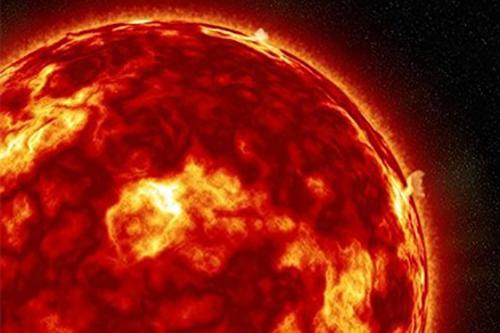Automated Solar Activity Prediction (ASAP) system makes prediction of solar activity faster, automated and more accurate
A system used by NASA and companies worldwide to better predict solar flares.
In a world increasingly reliant on communications technology, electricity and air travel, the threat of these networks being disrupted by solar flares is a major concern.
University of Bradford developed one of the world’s first automated real-time systems for the 24/7 monitoring and prediction of extreme solar flares - the system has a 70% accuracy rate and is so reliable it is used by NASA. It is also used by power companies, satellite operators, aviation and insurance companies, and meteorological institutes.
The Automated Solar Activity Prediction (ASAP) system makes prediction of solar activity faster, automated and more accurate. ASAP is also open source, meaning it can be used by anyone in the world.
The risk of blackouts caused by solar activity - including flares and coronal mass ejections - is expected to increase in the coming years as the sun enters the most active part of its 11-year cycle.
On March 11, 2015 and on September 6 2017, significant solar flares led to the temporary blackout of high frequency radio communications on the daylight side of Earth, while low frequency transmissions used for things like navigation were also affected - ASAP predicted this disruptive solar activity SIX HOURS before they occurred.

Rami Qahwaji, who led the development of ASAP, is Professor of Visual Computing in the Faculty of Engineering & Informatics at the University of Bradford. He says being able to better predict solar activity has huge benefits.
“The problem is that today we rely so much on technology for things like satellite navigation and communication and all of these things can be adversely affected by increased solar activity.
“Solar storms were first recognised as detrimental to power systems in Quebec, Canada in 1989, when 6m people were left without power after a series of solar flares. Another powerful solar storm, known as The Halloween solar storms [because they happened from mid-October to early November] happened in 2003 and resulted in the largest solar flare ever recorded, leading to power outages in Sweden and a visible aurora as far south as some Mediterranean countries.

“The power grids affected in the 1989 storm were knocked out in just 90 seconds. People are familiar with the Northern Lights and this is one visible effect of solar radiation. However, in addition to affecting our technology, it can also have an effect on us. For example, if you were to fly over the North Pole, you would be exposed to increased radiation. Solar radiation is also one of the primary concerns for any manned mission to Mars.”
ASAP is working with NASA’s Solar Dynamics Observatory satellite, integrated into NASA’s online space weather portal, used as a decision making tool for NASA’s robotic missions and to manage radiation effects on NASA’s Chandra x-ray observatory orbit, and is widely acknowledged as an international benchmark.
ASAP was also integrated with ESA’s Space Weather European Network (SWENET), between 2011 and 2013. SWENET is no longer operational, but to improve launch safety, ESA funded two ASAP updates in 2013 and 2015 to integrate it with the University of Malaga’s (Spain) Solar Energetic Particles (SEPs) prediction system, automating SEPs prediction for different forecast windows.
ASAP predictions (current and historical) are available publicly on NASA’s CCMC portal and at the Space Weather Research website. ASAP has been updated in 2022 to automatically tweet its predictions, when a significant solar flare is predicted.
Find out more
As part of our Research in Conversation video series, Professor Rami Qahwaji gives us some insight into the impacts of his research into space weather, how we can better predict it and why it is important for infrastructure on Earth.
